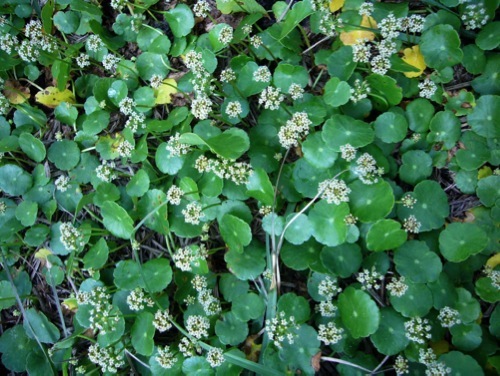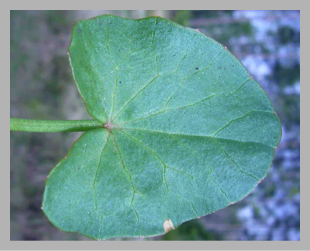A Pennywort For Your Thoughts
It’s one of those practices of civilization that plants with little flavor or calories — lettuce for example — are esteemed and popular, but, plants that can save your life have herbicides heaped on them. Case in point: Hydrocotyle bonariensis (high-dro-KOT-ill-lee boe-nar-ree-EN-sis) above, and its cousin, Centella erecta, (sen-TEL-la ee-RECK-tuh ).
In fact, a report in the Journal of Natural Medicines, 13 Feb 2008, found two new antioxidants in the Centella asiatica, discussed below, and presumably those are also to be found in the Centella erecta, below.
These perky relatives of the celery clan are prime invaders of southern lawns. You can’t blame them. Florida lawns are nearly perfect conditions: Sunny above, damp below with only decapitated grass for competition. That’s a pennywort’s definition of heaven, or a coinwort’s definition. It’s also the dollar weed’s idea, too. These “moneyworts” have many names and cash attached to their name, in more ways than one: You can buy them in powdered form in the health food stores; as tea or soda in Asian markets, or on their produce stand; as a side dish in an Oriental restaurant; or, change under your feet. In fact, I win a lot of bets with pennyworts: It makes a lot of cents.
I learned long ago at social functions not to mention I’m a writer because someone always thinks their life story is fascinating and will sell millions of books if I would only write it, payment out of the proceeds, of course. I’ve actually thought of telling people my occupation is robbing banks: I set my own hours, get to travel, I’m home on the weekends, I meet interesting people, the pay is good , I have federal holidays off and the vacations are long…. Anyway, everytime I say I know a thing or two about weeds and can find something to eat in almost anyone’s lawn that is often followed by “prove it.” In our manicured, raked and landscaped suburbs, the pennywort usually saves the day. It may also save lives.
Plants are natural chemical factories. These weeds have a chemical, like celery, that helps the aorta and blood vessels relax. They do that by increasing the amount of nitrous oxide available and that can lower blood pressure. In India, Centella has been used for that purpose for some 3,000 years. Nice of modern science to confirm it. The plant has a host of other properties as well from affecting blood cell development to wound care to reducing edema. It’s a little plant that can. By the way, Centella means “little coin” because the leaf surface is shiny and reflects light (and why all of the money names.) Erecta is upright. Hydrocotyle is from Greek meaning flat cup — the leaves can hold water — and Bonariensis translates into “of Buenos Aires” which is another way of saying South America, where they thought it came from originally.
The most common is the native pennywort, the round Hydrocotyle bonariensis, and the main lawn interloper. It’s about the size of a silver dollar under good conditions. Its stem attaches to the center of the leaf. Next is its close cousin, the Marsh Pennywort, or Hydrocotyle umbellata (um-bell-AY-tuh which means with umbels.) Equally edible, one often sees wading limpkins running across the top of floating masses of Marsh Pennywort, hoping to turn bug into bird. The Hydrocotyle bonariensis and Hydrocotyle umbellata are similar in appearance except the latter can easily grow far larger.
The Centella erecta is smaller than either and less common. Its one leaf is shovel- or heart-shaped and the stem is attached off center. This particular wetwort used to be called Centella asiatica (from Asia) but geneticists say the Centella in the southern United States is not exactly like the Centella in southern Asia, but they are so close only geneticists can tell them apart, or care to. While not a native, Centella erecta has been in North America for perhaps thousands of years, hitch hiking on the feet of wading birds they think. Incidentally, Hydrocotyle mexicana is also edible.
In Asian cooking the Centella is often called Gotu Kola. It‘s used, for example, as a leafy green in Sri Lankan cooking. As the dish “mallung” it is a traditional accompaniment with rice and curry. It’s also served with vegetarian dishes such as parippu. Charmaine Solomon, author of the Encyclopedia of Asian Food, says the Centellas:
“… have a slight bitter tang and are good to eat combined with shallots and lightly seasoned. Another way this leaf is taken is as a sweetened beverage. Look in the refrigerator section of large Asian grocery stores and there, among the canned soft drinks featuring tropical fruit juices, you will also find pennywort drink. The canned version does not appeal much in colour or flavour; but the drink made with fresh pennywort leaves is entirely different and very refreshing. Frothy and bright green, its piquant herb flavour sweetened by the addition of sugar syrup and poured over crushed ice, it quenches thirst and does you good at the same time. In Vietnamese areas, certain shops make it to order. If you have a supply of leaves, it is easy enough to make at home.”
If you are inclined to nibble some pennywort or Gotu Kola you should do two things. First, make sure you have someone who knows what they are doing identify them, particularly the Gotu Kola. There are a couple of look alikes in Florida that could confuse a novice. And, more than that, as a water-loving plants they’re quick to pick up and store pollution and bacteria or that pesticide you put on your lawn. Collect them from clean places.
And penultimately, in folklore pennywort tea supposedly helped one Chinese master live to 256. It also helped a king fulfill his husbandly duties to his 50 wives….. That should make it disappear from lawns.
Pennywort Salad
From Encyclopedia of Asian Food
By Charmaine Solomon
2 bunches gotu-kola or
about 250 g/8 oz/ 2 cups leaves without stems
3 shallots or
1 small onion, finely chopped
Good squeeze lime or
lemon juice
1 sliced chilli (optional)
75 g/2-1/2 oz/1 cup fresh grated coconut
Salt to taste
1/2 teaspoon sugar
Wash well and strip leaves from stems. Shred finely with a sharp knife, combine with other ingredients and serve immediately. The flavor is slightly sour, slightly bitter. Some people prefer this salad to be lightly cooked, if so bring a tablespoon of water and 1/2 teaspoon salt to the boil in a wok or pan, add all ingredients and toss over heat briefly, stopping before leaves lose their green color.
Green Deane’s “Itemized” Plant Profile
IDENTIFICATION: Hydrocotyle bonariensis, very smooth glabrous, stems slender, creeping; leaves on long slender stems, leave scalloped and stem attached in the middle of the leaf. With the Centella it attaches on the edge.
TIME OF YEAR: Year round
ENVIRONMENT: Any place wet to damp, lawns, parks, any place kept moist. Don’t collect them from ditches.
METHOD OF PREPARATION: Raw or cooked like any other green. Singificant amounts raw can lower blood pressure.



